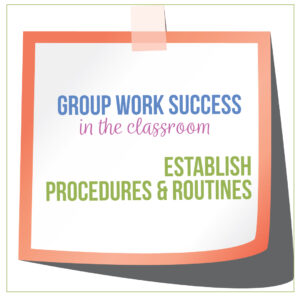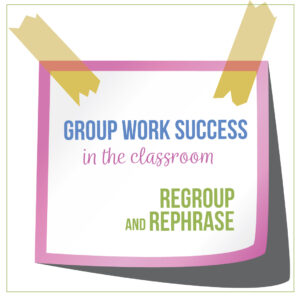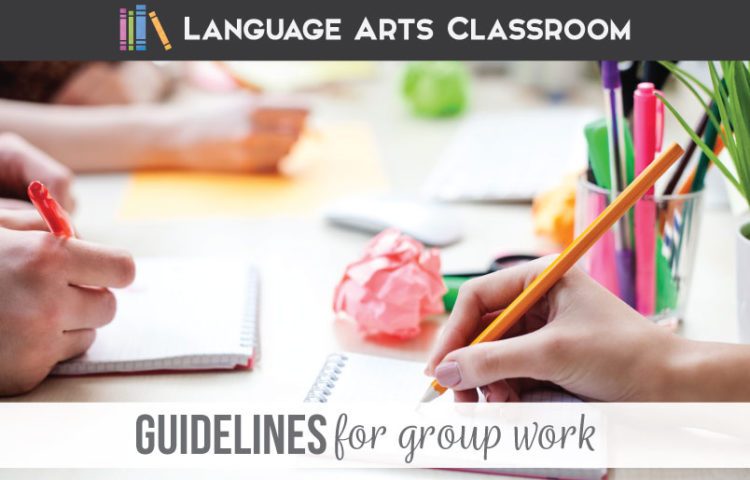Group work in the secondary classroom can greatly benefit students. With a bit of foresight, you can make the most of this time.
With guidelines and structure, group work can be a successful part of your secondary ELA classroom. “Group work” can have various definitions. I’m not referencing the structure of cooperative learning nor the assigned group project.
When I use “group work” in this post, I’ll be referring to groups made for class and not carried out of the classroom. This sort of group work helps with jigsawing and station work. I can casually assign students into groups if a class discussion starts to lag. If students are not active on a certain day, we can stand and move. Sometimes, students and I build such a wonderful classroom community that group work is an natural extension.
For instance, if students struggle with a topic, I’ll use group work so students can help each other. Sometimes, I make groups ahead of time and other times, I allow students to choose their groups. When my students form groups for those purposes, I consider the following ideas so that the process is successful.

Have a clear goal
Don’t simply move students into groups without an actual goal. My overall goal is to get students sharing ideas, but of course I have a specific goal too. My common activities are to revise and edit papers, to spur discussions, and to brainstorm. I explain the goal to students. When students understand they are to help each other find appropriate verbs (for instance), they focus on that idea. The goal of “work on papers” is often too broad, even for seniors.
They benefit when I provide opportunities to collaborate, of course. As a teacher, I have a goal too. I normally want to gather data for myself. As students relax in small groups, I can conference and decide the next lessons. Sometimes I walk around with a clipboard and blank piece of paper to write down common phrases. I then address those with the entire class.
For instance if students are answering questions about a piece of literature, I will jot down notes where students seem confused. I’ll also mark down where I hear intriguing ideas. I’ll highlight both as we regroup as a class. Future assignments, activities, and videos often develop after I overhear student discussions contribute to student buy-in.
Basically, group work does help students achieve a goal; however, I definitely have a goal for myself and gather data as students work.

Convey your procedures and expectations
I do believe the first time I asked students to work in groups, I flippantly told them to GO. Well, without establishing routines and procedures, students can interpret group work in a number of ways. Honestly, not telling students what we want is not fair to them, and you will probably be disappointed.
I share routines and procedures early in the school year. Before we break into groups for the first time, I review what students should do. Students can’t guess what you expect. Have your presentation ready to show students and spend 60 seconds outlining what students should do. It might seem like the process is a waste of time, but outlining what I want to see from students has never disappointed me.
Give students an image of successful group work. Do you want desks moved? Students on the floor? Mine use yoga mats, and I encourage intense discussions but require cordiality. Are their supplies students may use? Where are the materials? Do you not want certain materials (iPads or books) used? Overwhelmingly, teenagers hate being confused. When you outline what group work should accomplish and what it should look like, students won’t be confused.
And? I review the goal. Should students grow in their understanding of a character? Brainstorm ten possible research ideas concerning a topic? Working toward achievement of the goal is one of my expectations.
The next time we break into groups, I probably review the process again. At the end of the year, students can explain my expectations back to me.

Monitor and discuss
Grading papers and sending emails will probably call to you once students are working, but you’ll be glad that you walked around the groups. Help students stay on task and explain concepts as you move amongst students.
Proximity during instruction matters for student understanding and classroom management. You can do any entire pass of the classroom during group work. Not only can you verbally redirect students, but you can also use nonverbal communication to focus students. Try appropriate hand gestures, a tap on a desk, or a point to paper. Working alongside students also allows you to praise and encourage students.
Students will work if you listen and guide. Sometimes it helps to point out questions, rephrase directions, or ask an opinion. Acknowledging strong points that students make is always appreciated! Plus, use this opportunity to poke and move students forward in their understanding.
Of course, students will stay on task if you are in close proximity, but you can also clarify pieces as you circulate. Students are more likely to ask tough questions in a small group. Sometimes students won’t ask questions in front of the entire class. Use the group work as an opportunity to clarify.
Finally if you hear a repeated misconception about the material, take a moment to reteach with the entire class. Doing so leads to our next point.

Regroup, rephrase
If groups are not working, intervene. Call for a quiet minute and tell students to focus on their groups. It might sound silly, but model what a proper exchange of ideas sounds like.
For instance, you might prompt students:
- When someone has an idea you can’t see implementing, how could you respond? Yes, I hear you, and I think this angle ___ would also work.
- If a teammate isn’t speaking, how could you prompt them? Emma, what idea are you thinking?
- How someone presents options matters! Be sure to build off your teammates ideas and encourage additional insights.
Remind students of their purpose. You might try rephrasing your procedures too. If you’ve asked students to talk quietly, you can tell them to work within their circle so others aren’t overwhelmed.
Honestly? Most older students understand the expectations for group work. They simply need a reminder.
Please note: you are not a failure
We’ve all had classes where despite our best intentions and most clarified of expectations, students do not work well in groups. If the first experience doesn’t work, you might change how students group together. You might assign groups and provide a handout with guidelines for each group. Restructure, review, and retry.
If your school has an instructional coach, ask that person to provide feedback. If you really need groups to work, you could also film yourself to reflect. Implement a few ideas and experiment a bit.
Switch your methods but if after a few experiments and redirections your classes are not moving toward positive interactions in group work, table the concept. Group work greatly benefits students when done well but when students won’t work together, try different approaches. Some classes work better with gallery walks or digital collaboration (like on Google Slides).

Group work in the secondary classroom can be a powerful tool. Students should know their teacher’s expectations and the group’s goal. Often, working collaboratively will become a favorite tool for your students.

